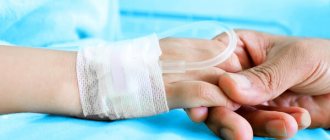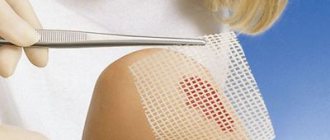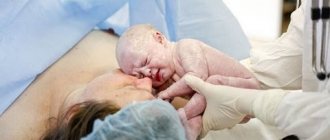Chickenpox is a viral disease that manifests itself in the form of numerous rashes on the skin. In rare cases, it forms on the mucous membranes. In childhood, chickenpox usually occurs in a mild form, without causing any complications. But parents are often concerned about the question of how to smear chickenpox.
Since the time of our grandmothers, such rashes have been smeared with brilliant green. It can have a powerful antibacterial effect. But these days, medicine offers a wide range of medications that effectively combat this disease.
How can you get chickenpox?
The causative agent of the disease is the Varicella Zoster virus, which belongs to the group of herpes viruses. It can be infected by airborne droplets. The child becomes contagious at the end of the incubation period and remains throughout the acute course of the disease.
Preschool children are more susceptible to the disease. But if a person did not have this disease in childhood, the likelihood of contracting the herpes virus as an adult increases.
Chickenpox is divided into mild, moderate and severe forms. The mild form is tolerated by the child without particularly pronounced symptoms. Minor rashes appear, body temperature remains within normal limits. In moderate and severe forms, more massive rashes are observed, large blisters with pus or blood appear inside.
Symptoms of chickenpox:
- high body temperature,
- severe itching,
- general intoxication of the body.
How to treat chickenpox in children, except brilliant green: modern and effective methods
Chickenpox or chickenpox, as we used to call the disease, is an acute viral infection that is transmitted by airborne droplets. The causative agent of the disease is the third type of herpes virus. Signs of the disease: fever and rash; pink blisters filled with liquid, which soon burst and become crusty. Pimples often cause itching.
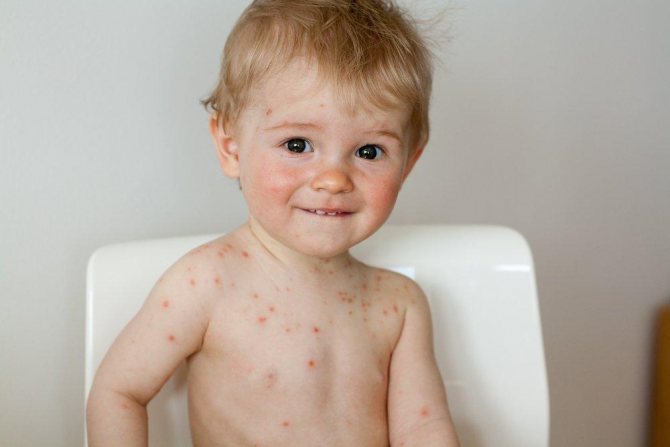
Every resident of the CIS knows that a child with green spots has chickenpox. There were even anecdotal cases where young fathers actually considered green spots to be a symptom of chickenpox. At the same time, outside the CIS, in general, few people know what brilliant green or brilliant green is.
The antiseptic does not bring any therapeutic effect, and does not affect the elements of the rash in any way, because brilliant green cannot cope with the virus. The product does not penetrate deep into the skin, but has an exclusively short-term effect on the bacteria that cause the rash.
So why do you need brilliant green for chickenpox?
It turns out that brilliant green is the easiest marker to determine how long a patient has been contagious. Mom applies the product to the affected areas every day and watches for new rashes. As soon as new pimples stop appearing, the baby’s coloring stops. And adults can be sure that after five days the baby will no longer be contagious. At the same time, any pediatrician will tell you that after all the blisters have crusted over, the child ceases to pose a threat to others.
But it is necessary to smear the rashes, despite the fact that such treatment is only symptomatic. Treating the rash reduces itching and pain. The healing process of scabs falling off is accelerated. These manipulations are to prevent the addition of a bacterial infection, which can lead to purulent dermatitis.
Products that can be used to treat rashes:
- Methylene blue;
- Fukortsin;
- Antiviral ointment Acyclovir;
- Colorless liquid "Castellani";
- Colorless lotion "Calamine";
- Powder "Baneocin".
Unfortunately, the chickenpox rash can also appear in the mouth and perineum. All this is extremely unpleasant. You need to fight it with the help of a solution of Furacilin, a 1% solution of Rivanol and chamomile decoction. In order to speed up the healing process, apply a gauze bandage soaked in sea buckthorn oil. If the genital organs are affected, sitz baths with the addition of a weak solution of potassium permanganate are recommended. Wash your child with furatsilin solution as often as possible.
Drug treatment of chickenpox
The most effective antipyretics are drugs based on Paracetamol or Ibuprofen. If you have chickenpox, never give the patient aspirin as an antipyretic. Chickenpox plus aspirin puts a huge load on the liver, which is fraught with consequences. It is best to consult your doctor about the use of antiviral medications.
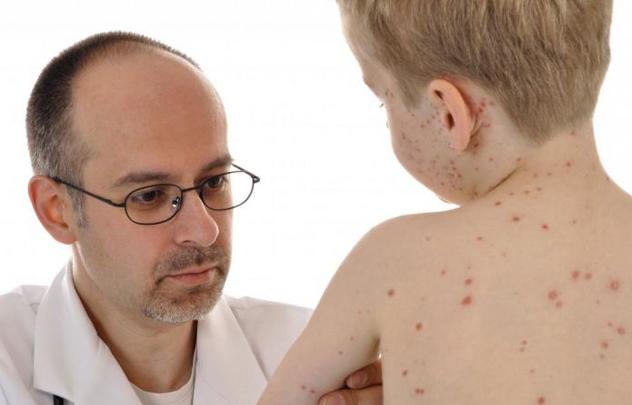
How long to apply on rashes?
New rashes appear within 3 to 10 days. All this time they need to be lubricated with an antiseptic. Antihistamines can be used for up to 20 days. Use antiviral ointments until all traces of the disease disappear. This will prevent the entry of a new infection, usually this period lasts up to 2 weeks.
Hygiene measures during the treatment of chickenpox
These tips will help you avoid bacterial infections and scars that will last a lifetime:
- Don't let your baby scratch the rash. Trim your nails on time.
- The house should not be hot. Recommended temperature is 20-21 degrees. Sweat can make the discomfort and itching worse.
- A daily change of both underwear and bed linen is required.
- Give your baby a non-hot bath. This is probably one of the most controversial issues in the treatment of the disease. American doctors insist on daily bathing or showering throughout the entire treatment period. Domestic doctors often categorically disagree with them. Parents will have to make their own decisions. In any case, if you are careful and do not rub your skin after bathing, but gently blot it with a towel, there will be no harm. And the child will feel much better, especially if there was a fever the day before.
Diet for the treatment of chickenpox
When treating chickenpox, the diet is aimed at neutralizing toxins and stimulating the immune system. Appetite in children usually decreases. If there is a rash in the oral cavity, then it is practically impossible to force the child to eat. The solution to the problem is a variety of decoctions and cream soup. They cover the oral mucosa with a film and reduce pain. The patient needs to drink as much as possible, this will reduce the level of toxins in the body.
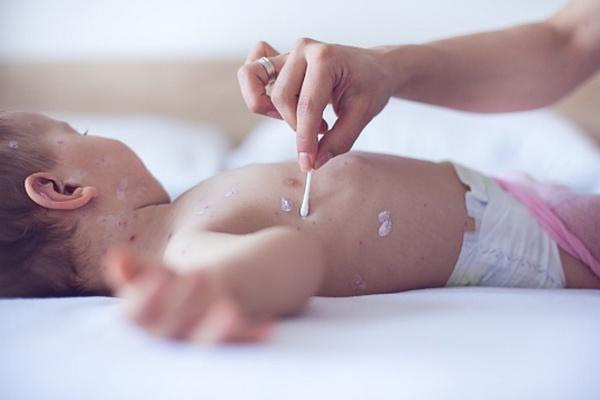
Recommended products for chickenpox:
- Cream soup. Well proven: potatoes, pumpkin, broccoli, carrots, cauliflower.
- Semi-liquid porridges and slimy cereal soups made from rice, barley, oatmeal and wheat bran.
- Freshly squeezed juices from vegetables perfectly increase the body's supporting forces: carrots, sweet pumpkin, celery root.
- Fermented milk products: low-fat cottage cheese, pureed in a blender; homemade yogurt without sweeteners; kefir with a minimum percentage of fat content; Ryazhenka These products contain probiotics and prebiotics, they improve immunity and normalize the functioning of the gastrointestinal tract.
- Berries and fruits without the presence of acid: bananas, sweet apples, peaches.
- Homogenized puree from lean meats. As you recover, expand your diet by adding steamed cutlets, vegetable dishes, and omelettes.
- It will be difficult to maintain immunity without the presence of vegetables. They are the main storehouse of vitamins. The diet should include seasonal vegetables and herbs: different types of cabbage, cucumbers, zucchini, squash, dill, basil, parsley.
- Baked pears and apples will be excellent absorbents for the intestines.
What you should not eat if you have chickenpox:
- Sour fruits: lemon, grapefruit, kiwi, tangerine, orange, cherry.
- Sweet refined foods: cakes, pastries, ice cream, sweetened drinks.
- Baking. Simple carbohydrates increase inflammatory processes.
- Milk makes your stomach bloat. It creates an environment in the mouth for the development of microorganisms.
- Remove smoked, canned, fried, salty foods from your diet. Such foods contribute to the formation of rashes and irritate the mucous membranes of the digestive system.
- Heavy cream, sour cream, cheeses.
- Rich broths.
- White cabbage, legumes, radishes. These products increase gas formation.
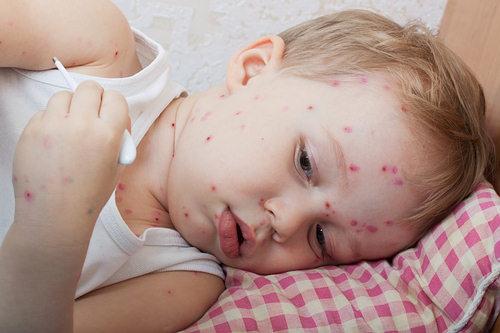
Source
Chickenpox rash
The rash associated with chickenpox is characterized by the appearance of various elements, replacing each other.
Sequence of manifestations:
- Stage 1. The appearance of spots. Small pink spots appear on the skin.
- Stage 2. After a few hours, the spots give way to papules. They look like reddish bumps. At first glance they look like an insect bite.
- Stage 3. Vesicles, inside of which a clear liquid is formed. The contents become cloudy over time.
- Stage 4. Sores where blisters burst. They tend to quickly become covered with crusts, which fall off after a few days. Full recovery occurs in 2-3 weeks.
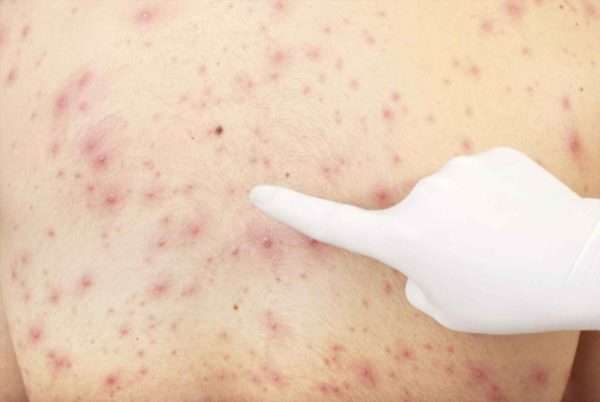
Chickenpox is an infectious disease, but in some cases it can cause complications in the form of suppuration and the formation of abscesses. When a secondary infection occurs, the danger manifests itself in the form of sepsis.
What happens if you peel off the scabs from chickenpox?
Chickenpox is a virus caused by type 3 herpes; it is a highly contagious disease that is transmitted by airborne droplets. The disease manifests itself in the form of pimples that are filled with clear liquid. With chickenpox, crusts form on the site of dropsy and cover the healing wounds.
Purpose
Chickenpox acne crusts form when the dropsy bursts and a sore appears. As with any other wounds, a crust is necessary in order to protect the body from viruses, infections or bacteria that can penetrate this way.
The appearance of crusts is due to the protective functions of the body. It also protects the body from re-entry of the herpes virus, which manifests itself in the form of shingles. The appearance of crusts is an important stage in wound healing.
How many are on the body?
The questions of the duration of the patient’s infectiousness and the healing period of the papules are the most interesting for those infected with chickenpox. Crusts form when the rash is more than 5 days old. They can form when there is dropsy. Wounds form or when an intact pimple dries out and a hardened area appears on it.
Usually the crusts fall off on their own 2-3 days after the wound is fully formed. The entire process of crusts appearing and falling off takes 10 days. At the site of the pimple, you can see a spot that is slightly darker than the color of the skin, which is due to pigmentation. Don't worry, the spots will lighten and match your skin color in 1-1.5 weeks. If you use medications, the healing process will take less time.
While the first papules that appear are healing, new ones appear and the rash stops. Usually by this time the infectiousness of the carrier of the chickenpox virus is reduced to zero.
Can I rip it off or not?
The crust falls off on its own and no trace remains of the wound; this is a natural process that is provided for by the body’s defense mechanisms. The formations disappear when the wounds heal and infection cannot penetrate there.
Not picking off the scabs of chickenpox is a difficult task for children, and adults often suffer from the habit of picking off scabs from sores. Such formations are unsightly, they are often noticeable, and are injured by clothing. The hands themselves reach out to rip off the sore, because you want to get rid of this uncomfortable phenomenon as quickly as possible.
Children always pick out scabs from wounds, so an adult should know what to do in this case. If a child has torn off dead skin, you need to treat the new wound with antiseptic preparations and agents that accelerate tissue regeneration so that the wound heals faster. Otherwise, bacteria, viruses and other pathological microorganisms will enter the body in this way, which will cause a strong blow to the body weakened by chickenpox.
If disinfection procedures are ignored, suppuration and inflammatory processes may begin in the wound. This can provoke various skin diseases or complicate the course of the chickenpox virus. Healing of a wound that has become infected takes longer than usual. A scar may remain at this location. It is best to wait until the scabs fall off on their own, especially in children, who find it difficult to treat wounds.
How to speed up healing?
Chickenpox needs to be treated symptomatically, so it is important to properly care for pimples and scabs so that not a trace of the disease remains. If the wound is injured, it is necessary to use pharmaceuticals that will speed up wound healing. Doctors recommend using products that enhance tissue regeneration and drugs that prevent infections. Anti-inflammatory medications are needed.
Such medications are useful for accelerating the peeling of crusts, as they disinfect the affected areas of the skin and soften the formation. The products will provide additional protection against infection. Thus, the skin itself quickly rejects the crust, which protects the body from pathological microorganisms.
Doctors recommend using Eplan ointment, which will heal wounds faster. It has bactericidal properties and softens the crust, in addition, the product is suitable for treating fresh wounds.
Levomikol ointment has a good effect on infected wounds with suppuration. It relieves inflammation by neutralizing pathological microorganisms. Baneocin has beneficial bactericidal and wound-healing properties.
For patients who like to pick off the crust, medications are needed to prevent the formation of a scar. Contratubeks ointment will help you cope with new scars and prevent them from forming. If a person sees that a scar appears at the site of the wound, he needs to smear the area with this drug. Zeraderm Ultra is more suitable for children. It contains fewer harmful components. The ointment has good disinfecting and wound healing properties.
tvoyherpes.ru
Goal of treatment for chickenpox
What to apply to chickenpox rashes in children? The most common remedy is brilliant green. It is capable of the following actions:
- anti-inflammatory,
- antiseptic,
- antibacterial.
This drug is also used to treat chicken pox, as soon as new blisters appear that need to be dried and disinfected.
The product is applied to the rash in order to prevent the addition of a bacterial infection and prevent complications of the disease. Under its influence, the child’s healing process is accelerated.
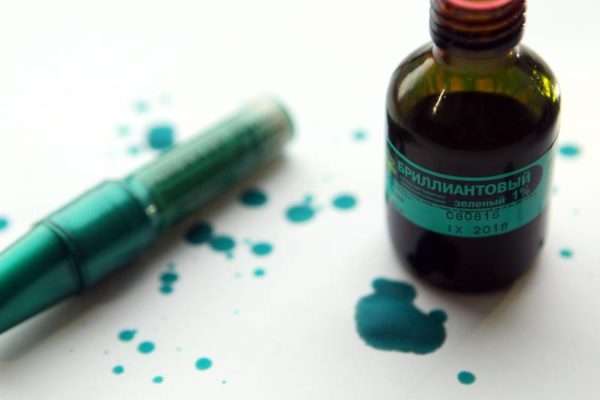
Benefits of greenery:
- does not cause side effects,
- controls the stage of the disease,
- no new rash appears.
One of the disadvantages is the unaesthetic appearance after its application.
Many people think that brilliant green should be used to burn pimples to relieve itching and destroy the virus that causes the disease. It's not like that at all. To eliminate symptoms and destroy the herpes virus, other medications should be used.
Treatment for chickenpox is carried out over 5 days, as new formations appear on the skin. It is enough to apply the product three times a day.
Medications for chickenpox
It is not advisable to use antibiotics on blisters - by this time the herpes virus has already gained a foothold in the body at the genetic level. The main task of influencing rashes is to prevent the multiplication of the herpes virus, drying out the blisters and reducing the intensity of skin itching.
Treatment with external drugs can alleviate the patient’s condition and prevent the formation of scars on the skin. It is much easier to prevent such a phenomenon than to eliminate it later.
Popular remedies used for chickenpox
When you don't have any brilliant green on hand, you can use alternative treatment methods.
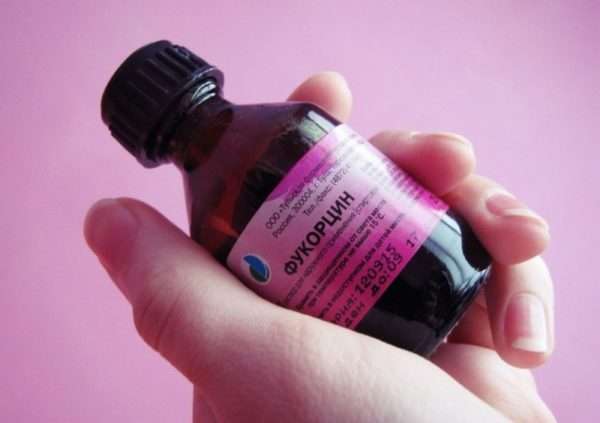
Similar means include:
- Potassium permanganate (potassium permanganate) – has an antipruritic and drying effect. For chickenpox in children, potassium permanganate is diluted in the form of a slightly colored solution.
- Furacilin - applied after the blisters burst. It is non-toxic, you can even wipe the genitals and perineum with it.
- Acyclovir ointment is used to destroy the causative virus. When applied, a sharp decrease in the intensity of the rash is observed.
- Calamine lotion is an antiseptic.
- Fukortsin - suitable only for children over one year old. This drug is contraindicated for newborns and infants. It should also not be applied to mucous membranes. The product is used for rashes that have formed on the skin.
- Zinc ointment – has an anti-inflammatory effect. The product actively dries out rashes. Suitable for all ages.
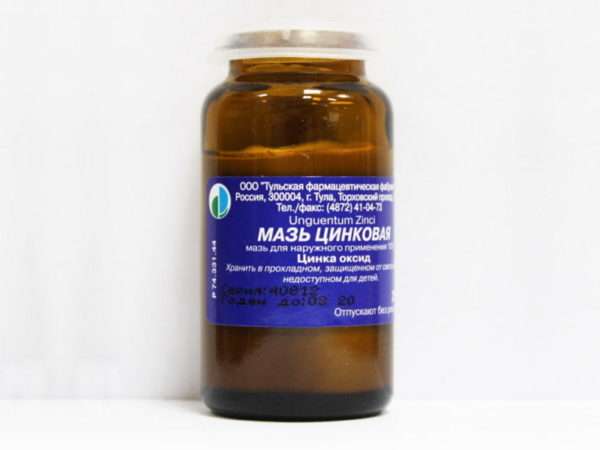
There are many other medications used in the form of tablets, ointments, creams and spray for chickenpox. The doctor selects individual treatment for each patient.
Sometimes parents ask: what is better to smear a child with chickenpox - brilliant green or fucorcin? The action of both means is similar to each other. The only thing is that the use of fucorcin is contraindicated for children under one year of age, and a burning sensation is felt when applying it.
What is the best way to smear your face after chickenpox?
It is very unpleasant when scars and marks remain on the face. Usually, if all the doctor’s recommendations have been followed, there are no scars after the scabs fall off. But when marks remain on the baby’s face, you need to think about how to lubricate the scabs after chickenpox so that they disappear without a trace.
The most effective means include:
- Bepanten cream - for chickenpox, improves metabolic processes and accelerates skin restoration. The drug should be applied in a thin layer to the affected areas twice a day. Application is possible at any age.
- Kantratubeks – effectively eliminates scars. The product should be used for at least three months. There is an age limit.
- Panthenol – promotes the regeneration of soft tissues and effectively eliminates skin irregularities.
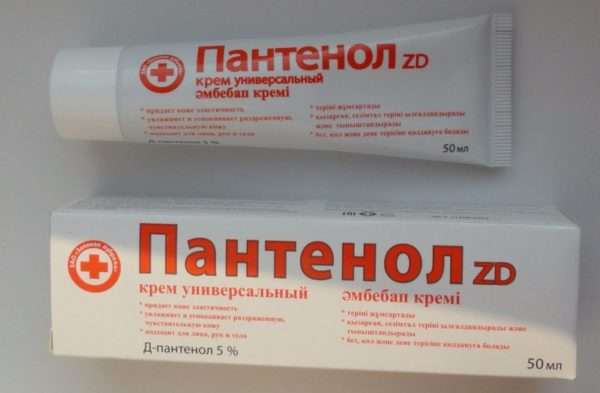
There are many drugs designed to eliminate scars formed after chickenpox. In any case, the doctor should select the remedy, especially if it concerns a child.
Why can’t you pick off the scabs when you have chickenpox and how long will it take for them to go away?
Hello, dear visitors of the dermatological site!
When chickenpox pimples begin to heal, crusts form in their place. Absolutely all doctors claim that they cannot be injured or torn off. Why? They serve as a natural defense to prevent infection of wounds by bacteria and viruses.
The sick person will not be in any danger only after the scabs fall off on their own. This process can take quite a long time.
Do you want to know how to significantly speed it up and how to properly care for dried blisters so that they don’t leave scars? Then you've come to the right place!
Why do we need crusts on wounds?
These durable formations are needed to protect the wound that appears at the site of a burst pimple from infections, bacteria and viruses. You can see what the crusts look like in the photo. As you know, chickenpox remains contagious for five days after the last blister appears.
Dry sores in this situation prevent re-infection. If the provoking virus is reactivated, shingles develops. That is why the protective function of our body, which creates these brown formations, is very important.
How long will the brown crusts be present?
This question interests everyone who suffers from chickenpox. They will go away on their own even if you don’t treat them with anything. But you need to take into account that the healing process will take longer. If these tumors are treated, they will heal faster.
Are you wondering how long it takes for pimple wounds to heal? This process lasts 10 days (on average).
In 10 days, the pimples will heal completely and the crusts will fall off only if they do not become inflamed or infected. And to prevent this from happening, there is no need to rip off the natural protection.
How to speed up the healing process of wounds?
The answer to the question: whether to smear wounds is obvious. Of course, you are wondering what to apply to these skin defects. Therefore, I have compiled a list of the most effective drugs that:
- accelerate healing;
- prevent infection;
- relieve inflammation;
- accelerate the regeneration of the epidermis.
These drugs can be used to smear not only wounds that do not have crusts, but also the sores themselves. The drugs will affect them as follows:
- disinfect;
- soften;
- additionally protect against infections;
- will accelerate the natural self-cleaning of the skin from crusts.
So, what kind of medicines are these? Fortunately, they are all affordable and safe (they have virtually no contraindications):
- Eplan is a wound-healing ointment for various types of dermatitis, burns, ulcers and wounds. The main property is microbicidal. In addition, it heals wounds and softens crusts. The ointment can be used to treat fresh wounds if there is a risk of infection.
- Solcoseryl is a regeneration accelerating agent. Apply a thin layer to problem areas of the epidermis several times a day. Quickly heals wounds and peels off crusts.
- Levomikol is an ointment for treating non-sterile festering wounds. Quickly kills the infection, instantly penetrates the source of inflammation.
- Baneocin is a wound-healing and at the same time bactericidal agent.
What happens if you rip off the protection accidentally or on purpose?
It is sometimes very difficult for us to keep track of our children, and even to restrain ourselves. Sores after an illness look unsightly, constantly become an eyesore, cling to clothes and create discomfort. Naturally, the sick person will want to get rid of them as soon as possible.
Children are especially partial to crusts. If a child has torn off a scab, parents need to carefully monitor the wound and be sure to treat it with antiseptics and wound-healing drugs. What happens if you don't do this?
An infection can enter into a wound with a torn protection:
After this happens:
- inflammation;
- suppuration;
- development of dermatological diseases;
- complication of chickenpox.
If you do not treat a wound that has no natural protection, it will certainly fester and take a very long time to heal. After this, a scar or dimple-shaped scar will appear in its place.
By the way, if pimples burst and are not covered with protection, and also take a long time to heal, then this is also abnormal and is fraught with the formation of scars. Wounds that arise in their place must be treated.
How to do this correctly? Read on.
How to prevent scars from appearing
Without waiting for the moment when the scabs fell off on their own, did you tear them off? What to do now? Is it possible to somehow prevent the appearance of a scar at the site of an injured wound? Fortunately, it is possible. The following medications will help you with this:
- Contractubex - perfectly heals young scars and prevents the appearance of new ones. The ointment should be used if a scar begins to form at the site of a recently healed skin defect. The sooner treatment begins, the faster the skin defect will disappear.
- Kelo-Kot is a silicone gel that prevents the appearance of scars. I recommend applying it to wounds that have healed with young dermis. Perfectly relieves the feeling of tightness and gives elasticity to young skin.
- Zeraderm Ultra is an ideal product for children. Disinfects and heals wounds, accelerates the process of epidermis renewal. It does not contain allergens or harmful substances.
- Kelofibrase - often used to prevent stretch marks, but can also protect against dimple scars.
That's all the information about crusts after chickenpox. Now you know what they are needed for, on what day they fall off during the normal course of the disease, and how to speed up this process.
I hope my tips will help you maintain the beauty of your skin. Be sure to tell your friends on social media about the article. networks by clicking the “share” button, and don’t forget to subscribe to site updates! Good health to you! See you again!
Author of the article: Elena Smirnova (dermatologist)
Publication date: 10-06-2016
kozhatela.ru
Chickenpox on the eyes. What to smear with.
The treatment is complex. It is based on drug therapy and local procedures. When chickenpox appears before your eyes, self-medication is simply unacceptable; all medications should be selected only by a doctor.
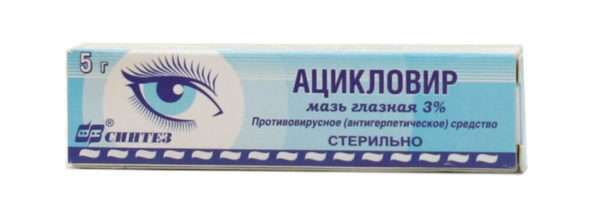
From the outside, the skin of the eyelids is treated with brilliant green, and an antiherpetic ointment is placed under the lower eyelid. To prevent infection, drops containing an antibiotic are selected. Ingestion of immunomodulators and antiviral agents is also recommended.
Which ointments are suitable for pregnant women
During pregnancy, many drugs that are commonly prescribed are contraindicated.
Treatment is as follows:
- use Acyclovir according to the scheme,
- smear the rash with brilliant green or fucorcin,
- observe daily hygiene and take a bath without using a washcloth,
- use antihistamines to relieve itching.
The herpes virus can penetrate the placenta and harm the intrauterine development of the child. Therefore, it is necessary to consult a doctor at the first symptoms.
Recommendations
The chickenpox virus can only exist in the human body. Once in the environment, it dies immediately. In adults, it “dozes” for the first time, waiting for the right moment. The disease can be triggered by decreased immunity or severe stress experienced.
Children experience the disease more mildly than adults. As mentioned earlier, the most effective treatment for chickenpox, both in children and adults, is brilliant green or a similar drug. But we must not forget that it is necessary to carry out complex treatment, which includes the prescription of anti-inflammatory, antihistamine, antiviral and antimicrobial drugs.



